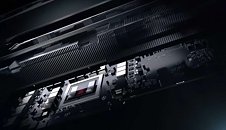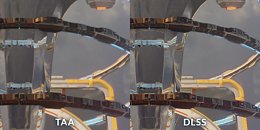Thursday, February 14th 2019

AMD Doesn't Believe in NVIDIA's DLSS, Stands for Open SMAA and TAA Solutions
A report via PCGamesN places AMD's stance on NVIDIA's DLSS as a rather decided one: the company stands for further development of SMAA (Enhanced Subpixel Morphological Antialiasing) and TAA (Temporal Antialising) solutions on current, open frameworks, which, according to AMD's director of marketing, Sasa Marinkovic, "(...) are going to be widely implemented in today's games, and that run exceptionally well on Radeon VII", instead of investing in yet another proprietary solution. While AMD pointed out that DLSS' market penetration was a low one, that's not the main issue of contention. In fact, AMD decides to go head-on against NVIDIA's own technical presentations, comparing DLSS' image quality and performance benefits against a native-resolution, TAA-enhanced image - they say that SMAA and TAA can work equally as well without "the image artefacts caused by the upscaling and harsh sharpening of DLSS."
Of course, AMD may only be speaking from the point of view of a competitor that has no competing solution. However, company representatives said that they could, in theory, develop something along the lines of DLSS via a GPGPU framework - a task for which AMD's architectures are usually extremely well-suited. But AMD seems to take the eyes of its DLSS-defusing moves, however, as AMD's Nish Neelalojanan, a Gaming division exec, talks about potential DLSS-like implementations across "Some of the other broader available frameworks, like WindowsML and DirectML", and that these are "something we [AMD] are actively looking at optimizing… At some of the previous shows we've shown some of the upscaling, some of the filters available with WindowsML, running really well with some of our Radeon cards." So whether it's an actual image-quality philosophy, or just a competing technology's TTM (time to market) one, only AMD knows.
Source:
PCGamesN
Of course, AMD may only be speaking from the point of view of a competitor that has no competing solution. However, company representatives said that they could, in theory, develop something along the lines of DLSS via a GPGPU framework - a task for which AMD's architectures are usually extremely well-suited. But AMD seems to take the eyes of its DLSS-defusing moves, however, as AMD's Nish Neelalojanan, a Gaming division exec, talks about potential DLSS-like implementations across "Some of the other broader available frameworks, like WindowsML and DirectML", and that these are "something we [AMD] are actively looking at optimizing… At some of the previous shows we've shown some of the upscaling, some of the filters available with WindowsML, running really well with some of our Radeon cards." So whether it's an actual image-quality philosophy, or just a competing technology's TTM (time to market) one, only AMD knows.



170 Comments on AMD Doesn't Believe in NVIDIA's DLSS, Stands for Open SMAA and TAA Solutions
No way TAA does FXAA-like effects...I can't believe this.
Run the benchmark yourself, DLSS is a lot better in Port royal than its TAA counterpart.
"exceptionally well on Radeon VI"
You mean Radeon VII, right?
The gaming heavyweights Sony & Microsoft would probably not look kindly on AMD creating proprietary solutions (like their PC competitor) which could potentially cause them issues later on. Creating open source multi-partner solutions makes more sense in their case, albeit probably with longer development times.
Look at the Metro Exodus and Battlefield V screenshots recently posted on Techpowerup.
Id take no AA over DLSS and just cant comprehend how anyone would be ok with blurry graphics, completely defeats the point of using a high resolution gaming screen if you're just going to upsample from a lower resolution and live with blur.
When Nvidia and AMD "optimizes" a game or benchmark they have a limited set of tools to work with. The most basic one is general rendering options, things like texture filtering, mipmap thresholds etc., the type options you see in the driver control panel, plus a few extra that are available through their native API. The second type of "optimizations" are tweaked shaders, but by optimized in this case it's generally not a feature complete optimization, but rather simplifying it without too obvious degradations in image quality. AAA titles and popular benchmarks are "victims" of this, and both vendors have been caught causing serious artifacts in 3DMark in the past. 3DMark is basically "broken" as a real benchmark at this point.
Then finally there are workarounds in the driver core per application. This is theoretically possible, but exceedingly rare (except for in that mess called Mesa). This is usually used to work around serious problems (bugs or bottlenecks) rather than actual optimizations, since any such workaround adds bloat to the driver.
Whatever DLSS does is applied to the whole mage after it is rendered, it is an upscaling solution nothing more. That's the equivalent of interpolating a signal, not filtering it. Post process AA like FXAA isn't a true method of AA either by definition, because there you try and alter the signal after it was sampled as well not while it is constructed.You don't, you use those cores only to make it faster.
They should entirely focus on the Ray-Tracing implementation instead, Metro is a nice showcase for them, after I saw the Ray Traced global illumination in metro exodus it really made me think that Ray Tracing has the potential to improve things in games, Cyberpunk 2077 is a good opportunity for nvidia, a game that most enthusiast PC gamers actually care about, they have a lot of time left to properly implement Ray Tracing in it and maybe make the game a true showcase for their next Gen GPUs.
Isn't the purpose of DLSS to use all of that extra crap nVidia added to the RTX series cards? It's more of a "Hey look, all that extra stuff you got actually isn't a waste!" This is like AMD saying, "Actually, it was. We already have open solutions that are perfectly adequate and widely used."